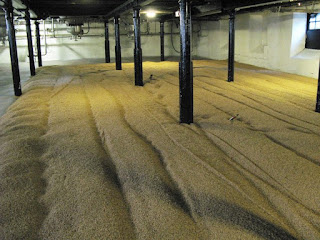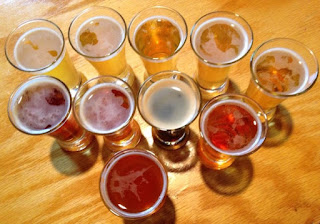 |
| Influence of grains on beer flavor |
Influence of Different Grains
Grains are the base ingredient and the foundation of the beer. They provide the flavor, color and aroma to the beer besides the sugars needed to create alcohol.Barley is the most common brewing grain, but other grains like wheat, rye, oats and rice may be used. Barley has excellent enzymes which create the fermentable sugars for producing beer and offers a clean, sweet, mild malt flavor, making it very versatile in creating different beer styles.
Barley can be categorized as 2-row or 6-row, depending on how the grain actually grows on the stalk. 2-row has two large kernels while 6-row has six kernels that are slightly smaller than 2-row kernels and have more enzymes.
 |
| Barley |
Wheat helps head-retention(frothy foam on top of the beer), provides texture and is the key grain in the German hefeweizen or a German style bock, weizenbock (weizen means wheat).
Oats give a smooth richness to the body and plays an important part in English-style oatmeal stouts, as it adds a smooth, rich, creamy texture to the stouts.
Rye adds a crisp, slightly spicy, sometimes dry aspect to the beer. Rice and corn, are neutral grains that do not change the taste but tend to lighten flavor.
A brewer may use these grains in different combinations to vary the texture, flavor and style of the beer.
How Grain Becomes Malt
Each grain contains starch which provides the sugar needed to make alcohol. Malting is the process that develops the grain enzymes needed for modifying the starch into sugar, and it involves a three step process—steeping, germinating and drying the grains with hot air.When the raw grain arrives at the malt house from the field, it is checked for quality control, sorted and cleaned before it is ready for the malting process.
The malting process begins with steeping, which soaks the grains in water to soften it and start the germination process. During steeping, by maintaining a good air flow and a warm temperature the conditions necessary for grain metabolism are triggered, which causes the grain to sprout. The sprouting of the grain is called germination.
 |
| Grain germination |
 |
| Malting floor |
Germination allows the development of malt enzymes in the grain which open up its starch reserves that produce complex sugars needed to create alcohol through fermentation.
The process of malting besides activating the enzymes and opening up the starch reserves acts as a purifier for the raw grain to create a safe beverage.
Barley is the most widely used grain for making malt but other grains like wheat and rye are also used for specific styles of beer.
Influence of Different Malts
The malted grains are additionally roasted to different levels which influences the flavor and color of the beer. The longer the grains are roasted the darker they'll become while also losing their sweetness and gaining a burnt bitter taste. This process is similar to toasting a bread which starts of having a light sweet bread flavor, and the longer it is kept in the toaster, it will change from a caramelized taste to a black, brittle and burnt flavor. |
| Different styles of beer based on different malts |
The lighter the grain toast during roasting, the lighter will be the color and malt flavor imparted to the finished beer; while heavier the toast, the darker the color and stronger the malt flavor that will be imparted to the finished beer.
Malts are categorized based on their malting and roasting processes. These processes which can be either combined or done on their own, influence the beer flavor, that can range from a light bread-like taste to caramel sweetness—lightly toasty to toasty—or dark and bitter with low sweetness.
A brewer may use these malts in different combinations to vary the texture, flavor and style of the beer.
 |
| Chocolate malt, crystal malt, and pale malt |
Pale Malt
Pale malt is produced by lightly roasting the malted grains which preserves all the brewing enzymes in the grain, and is very light in color. It is used as a base malt, because most of its starch reserves easily convert to fermentable sugars needed by the yeast to produce the alcohol. Pale malt can be produced from 2-row or 6-row barley.Depending on the degree of roasting, its flavor contribution to beer will vary from a lightly toasty and bread-like flavor to a slightly more nutty flavor. British pale malt is darker in color than the American pale malt and imparts a touch more flavor to the beers of England.
Pale malt is the most common type of base malt and forms the base for over 90% of all beers.
Pilsner Malt
Pilsner malt is a special kind of pale malt that is very lightly roasted and is used to make traditional German or Czech pilsners. It has a light color and provides a crisp, sweet, biscuit-like flavor to the beer.Vienna and Munich Malt
Both Vienna and Munich malt are produced by using a higher temperature during the malting process. Vienna malt provides a light toasty, malty sweetness to the beer.Munich malt is kilned (dried) at a higher temperature and a little longer than the Vienna malt, and as a result, provides a nutty, malty flavor to the beer.
Vienna malt is mainly used to make Vienna-style lagers which are similar in style to Oktoberfest (Märzen) beers. Munich malt is used for making Oktoberfest as well as in German lagers like the Munich dunkel and as the base malt for the bock style beers.
Crystal Malt
To produce crystal malt, the grains after germination are immediately heated at a higher than the normal temperature to quickly convert the starch to sugar and the malt is then roasted at a high temperature resulting in crystallized sugars. By varying the roasting temperature and duration, different caramel malts can be obtained ranging from light to dark and having a different flavor profile.Crystal malt provides a caramel sweetness flavor and texture to the beer. Since many of the sugars in the malt are caramelized during roasting, they are mostly unfermentable and the malt mainly influences the flavor besides the texture of the beer. Malts roasted at a higher temperature will have a stronger caramel flavor.
Crystal malt is mostly used in American and English ales, stouts and porters.
Chocolate Malt
To produce chocolate malt, the grains are dried and then roasted to a high temperature for up to around 2 hours, depending on the desired color and flavor requirements. The color can vary from light brown to near-black depending on the temperature and duration of roasting, and darker malts will add more bitterness to the beer.Chocolate malt is used to add color and flavor to the beer. When added in small quantities it causes a small change to the color in lighter beers while larger quantities causes significant darkening of the beer. Chocolate malt has low sweetness and adds a dark roasted flavor or coffee notes to the beer.
Chocolate malt can be used in most beer styles to add a little color but it is mainly used in the darker beers such as brown ales, stouts and porters to add color and flavor.
Black Malt
Black malt also known as black patent malt is produced by heating the grain at a high temperature until black, with no enzymes, and has a bitter, burnt flavor than other roasted grains.It is used in small amounts in porters and occasionally in stouts to obtain a dark color without impacting the flavor, or just enough quantity, to add a desired roasted flavor.
Unmalted Roasted Barley
Roasted barley is produced from unmalted grain by roasting at a high temperature until almost black and has a dry, bitter, roasted, coffee-like flavor.It is used in making stouts and some porters as it contributes majority of the flavor and the characteristic dark color to these beers.
Influence of Mashing and Steeping Process
Mashing is a process that allows the enzymes in the malt to break down the starch in the grain into sugars to create a fermentable liquid called wort. The process involves heating a mixture of milled or crushed grains and water. The grain mixture called 'mash ingredients' typically includes different proportions of malted grains along with some unmalted grains. |
| Grain mash |
The process of mashing influences the beer flavor, color and body of the beer. Through a procedure of controlled changes in the temperature of the mash, brewers can control the types of sugars that are produced by the enzymes.
Lower mash temperatures produce highly fermentable sugars creating beers with a higher alcohol content but a thinner body and mouth-feel. Alternatively higher temperatures create different sugar structures that are less fermentable, resulting in beer with lower alcohol but having more body and mouth-feel due to its thicker texture. Similarly medium temperatures will result in medium body beer.
Steeping is a method used to extract colors and flavors from certain types of darker malts by soaking in hot water. Unlike mashing, steeping is a simpler process that allows the brewer to only focus on extracting the desired color and flavor from the highly roasted malts that are mostly unfermentable.
Article Category: Drinks




No comments